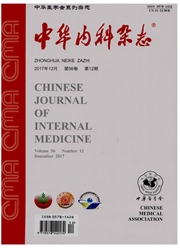

 中文摘要:
中文摘要:
目的 探讨视神经脊髓炎(NMO)脑部损害临床和影像学特征以及血清NMO—IgG和NMO脑损害之间的关系。方法 收集37例NMO患者临床资料,1.5T超导型MR扫描仪获取患者头颅及脊髓MRI图像,细胞免疫荧光方法检测血清NMO—IgG。结果 17例患者头颅MRI上发现异常信号;病灶主要位于大脑白质,侧啮室、中脑导水管和胼胝体周围及桥脑、延髓,根据病灶形态可将其分为散在不规则型(13/17例)、融合型(3/17例)、多发性硬化样(1/17例),以散在不规则型病灶多见;5例伴有脑干病变者主要临床表现为:嗜睡、呕吐、复视、视物旋转,其他脑白质区损害无临床症状,11例脑损害患者血清NMO—IgG抗体阳性。结论 约半数NMO伴有脑损害,病灶多分布于大脑白质、脑室旁、脑干等水通道蛋白4(AQP4)高表达区,临床表现与病灶大小无关而与病灶部位有关:脑干受累者易伴有相应临床表现,大脑白质病变无临床表现。血清NMO—IgG抗体检测有助于鉴别伴有脑病灶的NMO和多发性硬化。
 英文摘要:
英文摘要:
Objective To investigate the feature brain damage and clinical manifestations in neuromyelitis optica (NMO) patients; To investigate the relationship between seiMIn NMO-IgG antibody and NMO brain damage. Methods Clinical data of 37 NMO patients and their head and spinal cord MRI by 1.5T supereondueting MR scanner, were analyzed; serum NMO-tgG antibody were measured by immunofluorescence. Results 17 cases were found to have abnormal signals on MRI, which were mainly in the white matter, pons, medulla, ventricle, aqueduct, and around the corpus callosum; According to pathological changes, brain damage can be divided into scattered irregularity (13 cases) , fusion (3 cases) , multiple sclerosis-like (1 case) ,with scattered irregularity more common,5 cases had clinical manifestations of brain damage: somnolence, vomiting, diplopia, visual rotation, 11 cases patients with brainstem damage show positive serum NMO-IgG antibodies. Conclusions Brain damage can be seen in halt' of NMO patients, they often located in the high expression area of AQP4: brain white matter, periventricular, brainstem and so on. Clinical symptoms has nothing to do with the size of lesions but the location, they often occur when brainstem was involved. Serum NMO-IgG is helpful in differentiating NMO with brain damage and MS.
 同期刊论文项目
同期刊论文项目
 同项目期刊论文
同项目期刊论文
 期刊信息
期刊信息
